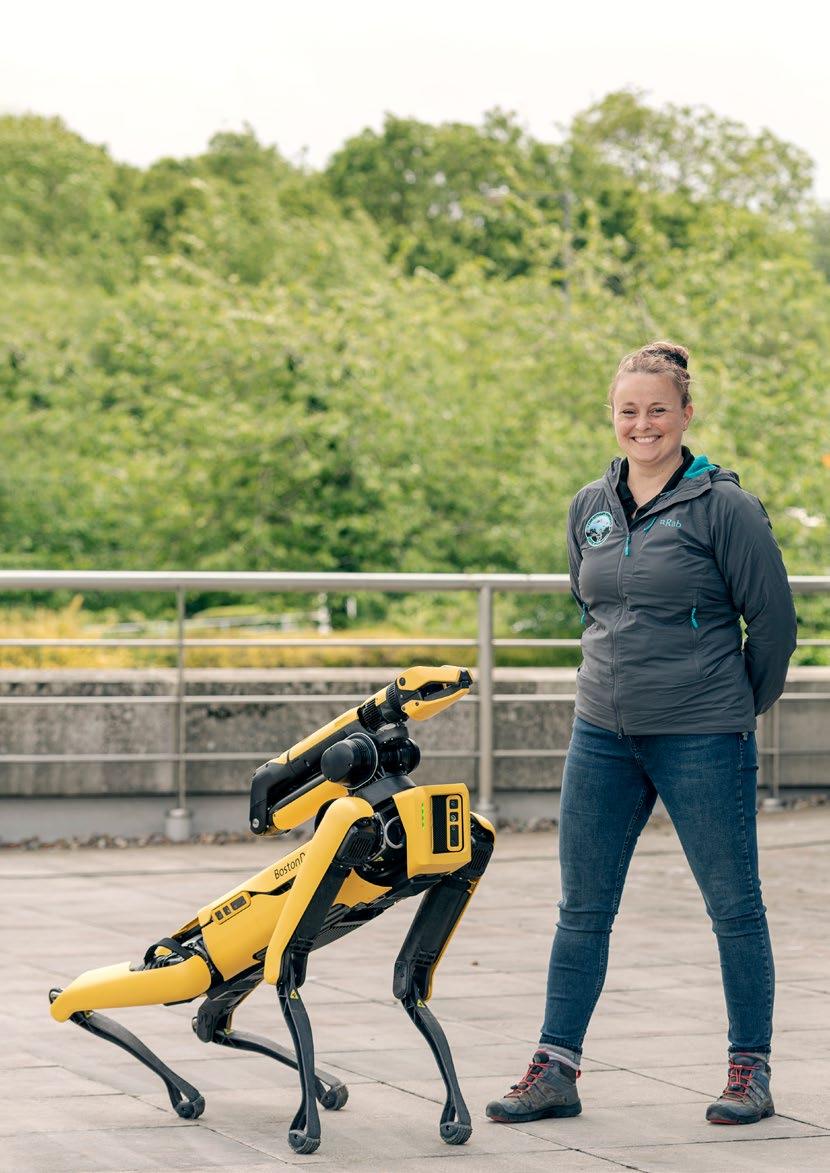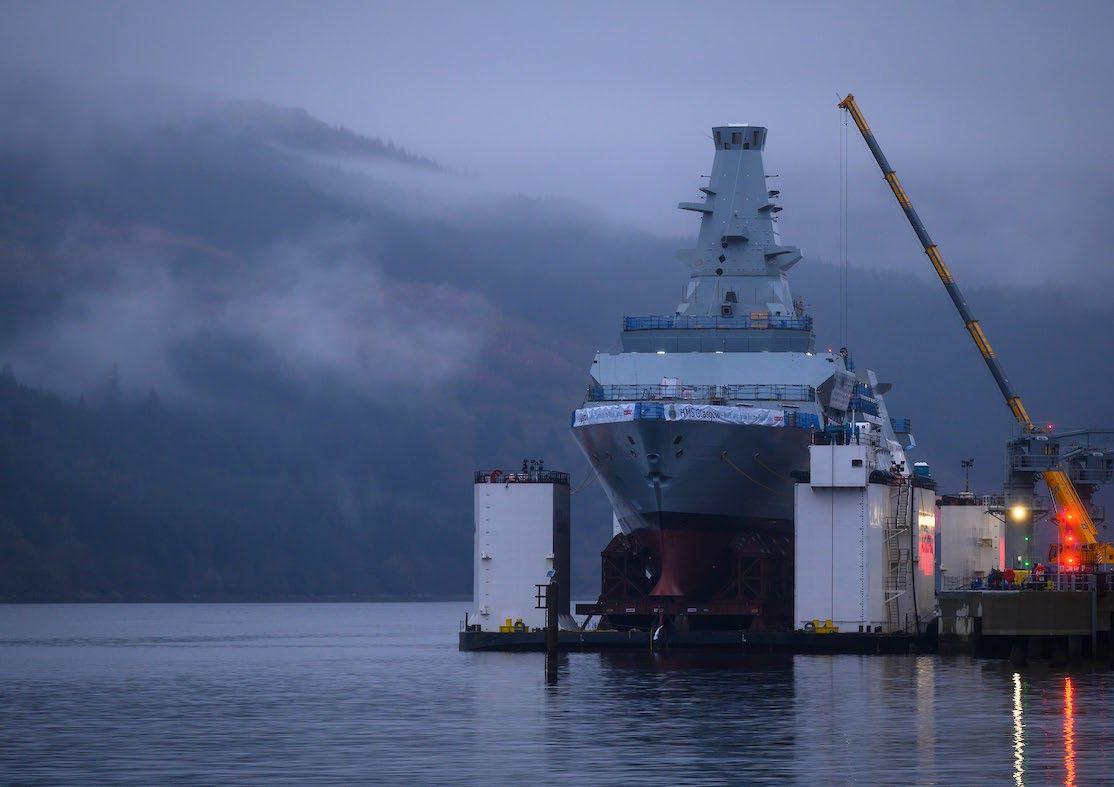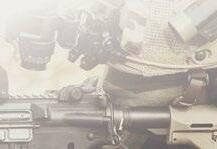














Last year, the world changed. Russia’s invasion of Ukraine brought the changing global threat environment into stark perspective. We rightly invested an enormous amount of time and effort in our crucial response to support the Ukrainian people. Ukraine’s brave and increasingly successful defence of their homeland means the war is at a critical crossroads, and our support continues to be as important as ever. This remains the highest priority for DE&S in 2023. In the face of the ongoing Russian invasion, the UK, along with over 40 other democratic nations, will continue to support the gifting and delivery of equipment and supplies to our allies in Eastern Europe. I’m confident our people in DE&S, and the UK Defence industry, will continue to work with agility and dedication to fulfil this vital mission. I again want to thank everyone involved in this effort.
DE&S provides essential support to UK Armed Forces operations around the world: maintaining equipment, and providing vital spares, equipment, consumables, medicines and logistics. Recognising this, we have renamed our Integrated Logistics function to the Operational Delivery function to better reflect what they do every day for our armed forces.
Responding rapidly to evolving defence operational requirements requires us to mobilise resources across DE&S and industry in an agile way. To reflect this enduring requirement, and to fully embed our support to Ukraine, we have also created a new Operations Directorate. The Operations Directorate is a relatively small, but senior, team that will ensure we give operational clients a single, simple front door to the full breadth of our capability – coordinating across our multiple domains. This is an exciting development and one that shows DE&S is alert, adaptable and agile to the changing world and the demands we face.
Last year was unrivalled in terms of the expectations placed on DE&S and Defence. And there’s no doubt this next 12 months will be increasingly demanding. Ever-evolving modern warfare
presents a real opportunity for change among the wider Defence delivery group. And we must increasingly work as One Defence team with our industry partners and internationally, responding to the challenges set by the UK Government and the wider Defence agenda. It’s essential that we collaborate to deliver a different type of defence system, otherwise we won’t be able to deliver our defence outputs at the pace they are needed.
In terms of the capabilities we’re developing, another key focus will be getting into a position where we can boost the effectiveness of our current assets more quickly by adopting and exploiting new technology. This is crucial. Our long-term capabilities must be able to stand up to threats from our most capable potential adversaries. Our service men and women deserve the pioneering equipment and support we can deliver.
An early objective this year is to land our refreshed strategy, which will provide the framework for future delivery, growth and success. Within this framework, we will continue our drive for further efficiencies and look to optimise our operational delivery. By this I mean working in a much smarter way. Global events are increasing demand and cost pressures and, to continue to meet our clients’ needs, we must further adapt to be more efficient and streamlined in how we work.
This is underpinned by all of the people who make up the One Defence team. Without them, none of the work we set out to do would be possible. It is through their expertise, extensive knowledge and commitment to our mission that we are able to generate the edge that our armed forces need to keep our nation safe, both today and tomorrow.

The ERCoE set up to create spaces where specialists from a range of disciplines with a shared purpose can come together to rethink old ideas and test out new ones. When the UK Armed Forces ask, ‘How can robotics change the way we work?’, our mission is to answer that. We seek out solutions by bringing together thinking and learning, pooling expert knowledge and experience from across the Defence community.
An example of the benefits this can bring is ERCoE’s support to the Royal Navy funded Heavy Lift Challenge. While ERCoE is funded by the Army, we are supporting and sharing the knowledge, investment and technology acceleration carried out by the Royal Navy across the defence architecture. When you’ve got cities being encircled, like we’ve seen in Ukraine, the ability to resupply forces quickly, effectively and directly is really important. Then consider that many Merlin helicopter lifts are for cargo weighing under 100kg. Why fly a mostly empty helicopter into a dangerous area, putting the lives of its crew at risk, costing thousands of pounds and taking a highly capable platform away from more important tasks, when you could send a cheap, uncrewed drone to do these dirty and dangerous tasks? The Navy are already looking at the utility of using drones for this type of work, and the Heavy Lift Challenge will help us understand how they could be employed by the Army and Air Force too.
We’re given the freedom to work differently, take calculated risks, seize opportunities, explore ideas and make unexpected partnerships. For example, in 2022 we ran the Robot Dog Olympics. We gathered 40 of the biggest brains in coding, and for two days they designed coding for our robot dogs for free. Why?
Because they wanted to get their hands on this cuttingedge equipment we had procured. Not only did this project give us 10,000 lines of code, greatly expanding what the robot dog can do in exploratory terms, but it also built relations with 40 individuals and their companies. Our work is about being a bit smarter. And collaborating with talented subject matter experts that share our vision.
I’m very excited about 2023. I’m looking forward to seeing previously disparate elements of our capability come together and the force multiplier impact this can have. We’re going to introduce technologies that allow a single service member to do the cognitive work of four people, freeing up personnel for other, more meaningful tasks. We will make our personnel more effective and make the most of their capacity.
Our human machine teaming project will be gamechanging for active battle. It has the potential to greatly improve efficiency, quickly deliver new capability and reduce the risks facing personnel in the field. That’s where the power and the multipliers come in. That’s where the efficiencies come in. And, most importantly, that’s how we increase soldier safety; that’s our main objective.
The ERCoE is leading this with the aim of providing the Armed Forces with the capability for a platoon enhanced through robotic autonomous systems by the end of March 2023. No small challenge, believe me.
We’re making a real difference to personnel, keeping them safe and away from danger, giving them better situational awareness and better technology. That’s why I’m both proud and motivated to be part of such an exciting and important team. We’ve delivered some great innovations and there’s even more to come.
Suzy Harris, Head of the Expeditionary Robotics Centre of Expertise (ERCoE), speaks to Desider about the increasingly important role of robotics in modern warfare and looks ahead to exciting developments in 2023.

The Executive Committee provides the collective senior leadership for DE&S and manages overall delivery and performance, ensuring that DE&S’ work meets the needs of the Armed Forces. It reports directly to the DE&S Board and advises the CEO in support of his role and responsibilities. Among its many duties the committee is responsible for setting the strategic direction of the organisation, business planning and development, commercial strategy, risk management, organisational security, and ensuring the culture at DE&S is built on foundations of excellence, inclusivity, collaboration and integrity.
The committee is made up of our CEO and his deputy (who also leads our Strategic Enablers programme), the heads of the three military domains (land, air and ships), and the directors of our HR, finance, commercial and corporate divisions. We asked each current member of the committee to tell our readers about their highlights from 2022 and their plans and priorities for 2023.
Adrian Baguley, Deputy Chief Executive and Director General
Russia’s invasion of Ukraine was a totemic event that dominated 2022. We should all take great pride in the support DE&S has given to help the Ukrainian people defend their country. When the Ukrainian Deputy Defence Minister visited Abbey Wood in November, he offer his personal thanks for the outstanding support DE&S has provided. This critical effort will continue in 2023 and remain a key priority for us.
The second momentous event in 2022 was the passing of our longest-serving monarch, Queen Elizabeth II. DE&S’ support to her funeral was impeccable. The Logistic and Support Operating Centre is already hard at work with skilled artisans across the UK producing ceremonial items for the King’s Coronation, including the State Colour and Sovereign’s Escort.
Looking forward, we must continue to drive out non-value-adding bureaucracy, maximise the use of standard tools and lean processes, and digitise as many transactional activities as possible to free up our people’s capacity to focus on value-added delivery. This is a vital priority in 2023 that will require the collective effort of all DE&S.
The coming year is an opportunity to harness the power of digital engineering to accelerate and enhance our equipment procurement and support activities. Digital exploitation brings with it a genuinely transformative opportunity. 2023 offers the prospect of being the year in which we turn our digital strategy into tangible benefits that will be taken forward by a number of pilot projects representing the variety of our portfolio.


2023 will be a year of delivering, both internationally and nationally. Internationally, the Prime Minister’s reiteration of the UK’s support to Ukraine means that the Land domain will continue to be at the heart of providing the equipment and stocks they need to defend their country. In addition, we are equipping Ukrainian soldiers undergoing training in the UK. In both areas this year, all three of our Land operating centres have been involved in supporting Ukraine while also balancing the continued delivery of capability into the hands of the UK Armed Forces. I am so proud of the way our people have reacted to the challenges of 2022. I know we’re ready to support again next year.
Nationally, in 2023 the Land domain, and all of DE&S, will be heavily involved in meeting the ambition of the Integrated Review. We have a range of armoured vehicle, weapons and helicopter projects moving safely and sustainably towards delivery, as well as various smaller projects that are crucial to each service person’s success.
Success this year and next is, however, a joint endeavour and my abiding lesson is the need for close working relationships between the Armed Forces and industry, with the ethos of One Team Defence driving pace and agility resonating heavily with my experience.
In many ways 2022 will be remembered for the war in Ukraine. Our response was another great example of how DE&S steps up when required. Commercial colleagues in our Weapons team, in particular, placed hundreds of contracts at very short notice, working closely with industry to keep supply lines running.
Throughout the year, high inflation and rising supplier costs have put pressure on the management of our supply chains, with shortages, restrictions, sanctions on Russia and fears of financial fragility across the sector. This is why we focused in 2022 on understanding the supply chain, so that we could identify issues and risks, and mitigate for them where possible. Our new supply chain resilience tool goes live early in 2023. Improving resilience will be a key area of work us, as part of the
DE&S 2025 strategy, and will be a priority going forward. Throughout 2022, we made positive progress with our category management programme, which employs strategic analysis to eliminate redundancies, explore capability opportunities and enhance front-line effectiveness. We now have a solid base to make this a business-as-usual way of operating.
It has been really positive to see how the Commercial function came together, both across DE&S and Defence Commercial. In 2023, we want to build on that progress and the great strides we have already taken towards achieving our Commercial Function vision: “To lead a connected, talented and inclusive community that continuously uplifts capability to deliver outstanding value for Defence.”

My personal and team priorities for 2023 are ensuring all that we do within the People Sphere is aligned to and underpins our organisational strategy. DE&S plays a critical role in keeping our nation safe, so creating an inclusive environment, where our people are skilled, engaged, empowered and inspired to be the best they can be, is vital. This is a key business imperative, and one HR recognises as its primary aim for 2023.
As I reflect on 2022, there have been many successes, and it is always difficult to call out just one. But given how incredibly competitive the employment market has been, I am hugely proud of the work the team has done on our
recruitment marketing. Their efforts won DE&S golds at both the Employer Brand Management and In-house Recruitment Awards, and a short-listing at the Recruitment Marketing Awards. As well as retaining our people, we have continued to receive thousands of quality applications, and ultimately energetic and highly valued new joiners to fill our vacancies. Moving from 2022 into the new year, I would like us to learn that simplicity is key! We tend to overcomplicate things at times and when, like now, we have an imperative to increase output for the UK Armed Forces, we need to simplify and streamline our policies and processes, and take out bureaucracy where it is getting in our way.
David Johnson, Director Finance
Looking back on 2022, I can think of lots of real successes. Indeed, we put a number of nominations forward for MOD, government and wider public sector awards. If I had to pick one example though, it would be publishing our Annual Report and Accounts before the Summer Parliamentary Recess for the first time ever. And without a single error in over 240 samples audited by the National Audit Office.
As always, we can identify areas where we want to keep improving. Financial forecasting is particularly challenging in today’s environment, with inflation, exchange rate
fluctuations and supply chain disruptions caused by the conflict in Ukraine and other factors. But it is important that we give our clients a realistic forecast with complete transparency about assumptions and risks.
As we go into 2023, we must keep a strong focus on continuing to do the basics well, and building on our hardwon successes. Beyond that, a particular priority for me will be to identify ways of streamlining and simplifying processes wherever possible. When we do this, it will free up capacity to help meet our resourcing pressures, and allow people to do more satisfying, value-adding work.
Last year the Ships domain had some phenomenal achievements that we will build on in 2023. Throughout the year ahead, we must continue to get the basics right, empower our delivery teams, and ensure an absolute focus on delivering equipment and ongoing maintenance to the Royal Navy. These themes will be central to how we take forward the DE&S strategy refresh in the Ships domain. To do this, we will need to learn new skills and make sure there is greater mobility of the skills already held by our people. For that to work, we will need to focus less on hierarchies and ownership, and more on local action and respect for what each of us contributes. Additionally, we will
use some big existing delivery projects to drive the changes we need to make to ensure the business keeps pace in a fast-evolving world. We must also continue to strengthen our relationships with other domains within DE&S and the delivery agents we work alongside. This includes the Submarine Delivery Agency, who play an essential role in delivering maritime outputs alongside us. I am excited about the year ahead, and if I can make one personal pledge it is to ensure that I continue to meet and engage with as many of our UK Defence Team as possible – those from DE&S, industry and Front-line Commands – as we continue to deliver together for our Armed Forces.
The response of the Air domain to the Russian invasion of Ukraine has been wide-reaching. We have supported significantly increased flying rates across our combat aircraft, tanker, surveillance and air mobility fleets, while accelerating capability enhancements. With the pandemic not yet in the rear-view mirror, this sustained effort has required great and continued collaboration with our industry partners, who responded without question.
Among the many project milestones reached in 2022, of note were the arrival of the three E7 aircraft, which are now well through their modification programmes; UK acceptance of its first Protector uncrewed system; and the Envoy aircraft reaching Initial Operating Capability only eight months after work began in earnest on the programme. Air domain teams have also responded brilliantly to many unforeseen technical discoveries,
which have impacted safety or reduced availability without warning, requiring innovation and resilience to rectify; efforts that are seldom recognised.
Notwithstanding these hard-won successes, we must continue to strive to do more and continuously improve, particularly by getting the basics right, with programmes delivered on schedule, and risks foreseen and mitigated to ensure that our clients are not presented with capability gaps or growing costs.
As I look forward to 2023, my focus for the Air domain will remain to deliver on our promises to the frontline, particularly adherence to schedules and being relentless in driving up availability. In our efforts, we should never compromise safety, but recognise that risk is contextual and must always be tailored to the specific operational circumstances.

 Vice Admiral Rick Thompson, Director General Air
Vice Admiral Rick Thompson, Director General Air
Three-year contract to provide specialised engineering support to the Future Combat Air Systems programme.
A £31 million contract to provide highly specialised engineering capacity to the Future Combat Air Systems (FCAS) programme has been awarded by DE&S to the Aurora Engineering Partnership, led by UK defence firm QinetiQ.
Under the three-year contract, delivered through the Engineering Delivery Partner (EDP) framework, Aurora will provide technical support to FCAS and the DE&S Catalyst delivery team, which is responsible for delivering the latest combat air capabilities to UK front-line commands. The support will initially focus on human performance, safety and systems engineering disciplines. This will enable DE&S to deliver essential engineering strategies for future FCAS capabilities.
Group Captain Mark Butterworth, Deputy Head Catalyst and Chief Engineer for the FCAS portfolio at DE&S, said: “This was a fantastic opportunity to further reinforce the highly skilled DE&S engineering workforce with individuals who possess an in-depth and invaluable level of knowledge and expertise in specific technical areas.”
The FCAS programme currently employs around 2,500 highly skilled people across the UK, including at combat air sector industrial hubs in Scotland, and in northwest and south-west England. This new contract will support around 45 jobs based in Bristol, Boscombe Down, Farnborough, Malvern, Bath and Lincoln.
Nic Anderson, QinetiQ’s Chief Executive UK Defence, said: “The Aurora Engineering Partnership with the UK MOD and DE&S continues to go from strength to strength, providing technical support to the most complex acquisition programmes. Our work with the Catalyst delivery team will help accelerate new ways of working
using digital engineering methodologies in supporting the next generation of combat air platforms.”
Aurora partners Atkins and BMT will also be involved in delivering the contract, along with a number of subcontractors in the EDP provider network.
Richard Berthon, Director Future Combat Air, said: “This contract with Aurora and QinetiQ is a demonstration of our commitment to working with the UK’s leading defence technology companies on FCAS. Their expertise will be vital to the programme as we work at pace to deliver a next-generation combat air capability by 2035.”
Minister for Defence Procurement, Alex Chalk, added: “The Future Combat Air Systems programme continues to make good progress, as demonstrated by this
latest engineering contract. I am delighted that highly skilled UK industry personnel will lend their support and expertise to the programme, as we work together to deliver a next-generation fighter jet for the future.”
It was recently announced that the UK also will work with Italy and Japan to adapt and respond to the security threats of the future through an international aerospace coalition called the Global Combat Air Programme (GCAP).
GCAP will harness the combined expertise and strength of each countries’ defence technology industries to push the boundaries of aerospace engineering. It will allow the UK to utilise Italian and Japanese expertise, share costs and ensure the RAF remains interoperable with our closest partners.



Prime contractor BAE Systems has led the float-off process of the Royal Navy’s first Type 26 frigate, where the ship was lowered from a barge into the deep water of Loch Long for the first time. The ship – weighing nearly 6,000 tonnes – was then towed back up the River Clyde to a deep-water shipyard in Scotstoun, west Scotland, where it will undergo outfitting, testing and commissioning.

The float-off involved the base of the barge sinking slowly over several hours, with engineers checking progress regularly, until HMS Glasgow fully entered the water. A float-off is a more efficient and low-risk way for a ship to enter the water compared to the traditional dynamic launches from a slipway.
Replacing the bulk of the retiring Type 23 fleet, the Type 26 will be a flexible and advanced warship. Its primary purpose will be anti-submarine warfare, protecting the UK’s continuous at-sea nuclear deterrent and Maritime Strike Group. They have been procured and are being delivered by DE&S.
Defence Secretary Ben Wallace said: “HMS Glasgow entering the water for the first time marks a major milestone for the Type 26 programme, which supports thousands of highly skilled
jobs in Scotland and more across the wider UK supply chain. We’re continuing to invest in the British shipbuilding industry to maintain the Royal Navy’s cutting-edge ability to defend our nation, while strengthening our partnership with allies.”

The exact timing of a float-off is dependent on weather conditions and tides to ensure the safety of the teams involved and the ship itself.
Pat Browning, DE&S Type 26 team leader, said: “Float-off is not only a key milestone in the build programme for HMS Glasgow, but, as first-in-class, it is a key milestone for the Type 26 programme as a whole. Engineers from DE&S, as well as members of the Royal Navy, will be supporting BAE Systems in this complex process.”
The BAE Systems teams involved in the float-off were specially trained using a 3D visualisation suite that gives engineers access to a complete digital version of the ship.
HMS Glasgow is the first of eight City-class frigates to be delivered to the Royal Navy. HMS Cardiff and HMS Belfast are also under construction, with Glasgow expected to enter service in the late-2020s.
has reached a major milestone, entering the water for the first time.
We are taking the best of existing technologies and spiral-developing them into future systems, to ensure the Royal Air Force has the capability it needs today and tomorrow.

As we start 2023, many of us will be thinking about making resolutions for the year ahead. While sticking to those ambitions can be a challenge, over the next 12 months all of us at DE&S will remain committed to making our country and the world safer.
From the war in Ukraine to the impact of climate change, and emerging and disruptive technologies, we face many threats to the way we live our lives. They demand that we work together with our allies around the world to defend our interests, developing the One Defence approach abroad as well as at home.
Towards the end of last year, I met Ukraine’s Deputy Defence Minister Volodymyr Havrylov after his visit to DE&S. I heard how, by working together, we are making a huge difference to his country’s ability to defend itself against Russian aggression.
The UK was the first European country to provide weapons to Ukraine. So far, we’ve committed more than £2.3 billion worth of military aid, including armoured vehicles, anti-tank weapons and other armaments. Billions more have now been committed by our partners around the world. We can be proud of the role we continue to play in supporting Ukraine.
Through our close partnerships with industry we have identified the challenges we face to meet the demand of supplying Ukraine. In the year ahead we need to strengthen our relationships with businesses, and continue to understand and meet their needs – recognising the important part they play in One Defence and in the UK’s economic interests.
Since starting my role at DE&S in September, I’ve regularly met with NATO allies, international partners and industry leaders to discuss how we can do more together and do better. The challenges are complex, but by working closely with
our allies, the UK is providing leadership while promoting our national interests on the world stage.
Our partnership with Estonia, for example, will enable NATO to maintain its technological advantage through the Defence Innovation Accelerator for the North Atlantic (DIANA) initiative. From its European HQ in London, innovators, industry partners and universities will develop cutting-edge hi-tech solutions across two-thirds of NATO’s 30 member countries. DIANA is a prime example of One Defence in action, working not only for our national interests but our global responsibilities too.
The UK is also collaborating with our closest allies to influence NATO’s work on supply chains, so industry has the materials and orders it needs to invest and meet demand.
We’re looking at ways to improve how NATO countries share and use equipment and ammunition. And we’re leading efforts to improve the way NATO develops and delivers some of its biggest and most
expensive projects.
As a leading NATO member, the UK should continue to influence the way the Alliance acts in the year ahead. This includes via NATO’s Conference of National Armaments Directors, where we must make sure the views of industry are heard when we take decisions that affect them.

We need to step up our efforts in all these key areas in 2023. Doing so means we can face current and future security threats together. It also means NATO gets stronger and takes better decisions, which lead to better outcomes.
We should see the start of the new year as a chance to look at the way we did things before and find even better ways of doing them in the future.
We should look at who we work with to achieve our goals, recognising the value in partnerships in building the One Defence team. Sharing ideas and best practice by working more closely and effectively with our global partners should be our shared resolution for the year ahead.

More than 250 ‘portable’ and ‘packable’ mini-drones will be delivered to the UK Armed Forces, as part of a £129 million contract with systems integrator Lockheed Martin UK.
The new Mini Uncrewed Aerial Systems (MUAS), which can locate and identify targets far from troops on operations, are due to be operational by the end of 2024.

Weighing just over 20kg and with a 4.88 metre wingspan, the portable Stalker drone can be vertically launched and is near-silent. Once in the air, it can cover around 60 miles and provide more than eight hours of imaging.
The packable Indago 4 drone weighs only 2.27kg and can be folded and carried in a soldier’s backpack. At the right moment it can be deployed in just two minutes with a range of approximately eight miles. Its high-resolution camera provides incredible zoom capability to accurately identify people, objects, vehicles and weapons, day or night.
As part of the Tiquila programme, managed by DE&S, both drone platforms will replace existing systems. They will deliver cutting-edge surveillance and provide greater capability for UK Armed Forces.
Brigadier Pete Drew, the Army’s Senior Responsible Owner for the Tiquila programme, said: “Tiquila will bring the next generation of remotely piloted air systems into service in the Army. It will provide the means for the capability to remain at the leading edge of innovation allowing it to adapt to new threats.”
Already used by the US military, the drones are designed to provide small military formations with immediate intelligence, surveillance, target acquisition and reconnaissance (ISTAR) capability –an increasingly vital component in modern battle spaces.
Lockheed Martin UK will be the systems integrator for the duration of the 10-year contract. They will work with various small and medium enterprises and larger drone manufacturers to iteratively develop the capability. This will ensure the UK Armed Forces maintain their operational advantage by upgrading the drones and keeping pace with technological changes and emerging threats when required.
Air Commodore Steve Bentley, UK Strategic Command’s Senior Responsible Owner for Tiquila, said: “Employing a systems integrator approach will ensure that UK Defence is able to make the most of innovative development and the Tiquila programme’s rapid capability integration cycle, to deliver the latest and best capability into the hands of our users on the front line.”
More than a dozen full-time UK jobs, from engineering and commercial, to project management and support roles, will be sustained at Lockheed Martin UK over the contract’s duration, mostly in Havant and Gloucester. Further supply chain roles across the UK are expected to be supported throughout the contract.
Lockheed Martin UK will be the conduit to a collection of additional UK and international companies known as the Tiquila Enterprise. This will ensure that Tiquila is able to access the best technology and ideas, and rapidly integrate them into their Stalker and Indago platforms.

























Civil service and military personnel from across DE&S are among those who have been recognised by His Majesty The King in this year’s New Year’s Honours list for their bravery, commitment, exceptional hard work and commendable service to the UK. Here, Desider puts a spotlight on those who have been recognised for their outstanding achievements.
DE&S Special Projects Tactical Communications team leader Colin Leat was awarded an Order of the British Empire (OBE) in recognition of his digital communications work during his time as portfolio manager. On his recognition, Colin, said: “I really am so proud of what DE&S do and what we provide, but I would never have thought I would be recognised in this way. So many people are so deserving. It’s very special.”
Rosslyn Hill, DE&S Occupational Health & Safety Environmental Co-Ordinator in the Strategic Enablers domain, was awarded the British Empire Medal (BEM) for her services to Defence and mental health.
After 34 years in the Royal Navy, Vice Admiral Paul Marshall, DE&S Director General Ships, was awarded the Companions of the Order of the Bath (CB). “Paul has served in major programme delivery roles as a Captain and Commodore. On promotion to Rear Admiral, Paul became the first Director of the Naval Acquisition portfolio and the Senior Responsible Owner for the Fleet Solid Support Programme. In 2022 he assumed the position of Director General Ships, responsible for the acquisition and support of the Royal Navy surface Fleet.”
Pete Saul, DE&S Sentry team head, was awarded an OBE for restoring the Sentry capability and its successful export to Chile following withdrawal in the Integrated Review. On his recognition, Pete, said: “After more than 5 years of collective hard work to transform the Sentry programme, it feels like a wonderful time to be recognised in this way. Without the opportunity to be challenged and without having great people to work alongside, I couldn’t have been worthy of this recognition.”

Pete Skinsley, DE&S Logistics Support Assistant Head in the Land domain, was also awarded an OBE in recognition of his work supporting the Permanent Joint Headquarters, which commands joint and multinational military operations on behalf of the MOD.
Warrant Officer Phil Bedson
Service Medal Warrant Officer Phil
Engineer, was awarded a Meritorious Service Medal (MSM). The MSM recognises long-term service in the armed forces of noncommissioned ranks.
DE&S
Lieutenant Mark Harbon – Air Officer Commanding 22
While working as Deputy Squadron Commander of the Aerosystems Training Squadron, Hawk Deputy Change Manager Mark, was awarded a commendation for leading safe training delivery for the hundreds of Technicians and staff under his command throughout the Covid-19 pandemic. On his award, Mark, said: “This award is not just a reflection of my actions, but that of the whole team during very challenging circumstances.”
Flight Lieutenant Steve Swart was commended for the work he undertook while in his role in the Mechanical Transport Squadron at RAF Wittering. Steve’s support to the Home Office in the relocation of Afghan citizens under the Afghan Relocation Assistance Policy contributed to his commendation.
Lieutenant Commander Rob Wheeler – Vice Chief of Defence
Rob was recognised for his impactful work while deployed with the Royal Navy of Oman as Fleet Weapon Engineer Officer. On his recognition, Rob said: “I didn’t expect it at all. When you think about how many people are in the armed forces and the MOD and the list of people who could be recognised, it is a real privilege.”


The UK has provided thousands of NLAWs to Ukraine to support the defence of their nation following Russia’s invasion. Using the NLAW system, a soldier can take out a heavily protected modern battle tank from 20-800 metres.
These will be assembled at Thales’ facility in Belfast, Northern Ireland.
The contract was signed after the UK Defence Secretary Ben Wallace met with his Finnish and Swedish counterparts during a recent visit to Oslo for a meeting of the Northern Group. They examined the equipment and discussed the impact of the conflict on shared security, as well as the success the NLAWs have had on the battlefield in Ukraine.
Mr Wallace said: “These nextgeneration light anti-tank weapons have played a decisive role in supporting Ukraine’s army to drive
back Russia’s illegal invading forces.
“Working with our first-class industry partners, we are continuing to fulfil our commitment to NATO by ensuring our armed forces will receive a steady supply of these weapons over the coming years, while supporting UK jobs across the length and breadth of the country.”
NLAW is a shoulder-launched missile system that attacks a tank from above. It combines the simplicity of light antiarmour weapons with the advantages of heavy, crew-operated guided missile systems. This agility, reliability and accuracy has made the NLAW an important capability in Ukraine’s fight against Russia, making up part of the 10,000 anti-tank weapons the UK has supplied to the Ukrainian Armed Forces.
The contract will see several thousand units delivered to the UK Armed Forces
between 2024 and 2026, in addition to around 500 that will be delivered in 2023 through a separate procurement.
Chris Bushell, DE&S Director General Land, said: “Since the start of the Russian invasion, teams across DE&S have been working with speed, agility and dedication to supply crucial weapons and equipment to Ukraine. We have seen how effective anti-tank weapons like NLAW have been during the conflict and we continue to stand firm in our support to Ukraine. We will continue to work to support Ukraine while we replenish the weapon stocks for UK Armed Forces.”
The UK continues to actively engage with industry, allies and partners to ensure we can equip Ukraine with vital military support, while replacing at pace the equipment and munitions granted in kind from UK stocks.
light anti-tank weapon (NLAW) systems.



HMS Defender’s return to Portsmouth caps an outstanding year for the ship, having sailed more than 27,000 nautical miles and been involved in three major operations. The Type 45 destroyer has operated in the High North, the Baltic Sea and, more recently, in the Mediterranean.

Commander Peter Evans, HMS Defender’s new Commanding Officer, who arrived in early November while the ship was in Gibraltar, said: “Although I’ve only recently joined Defender, it’s clear that the focus, ethos and esprit de corps is something special on board. Her accomplishments this year read like several ships’ worth of activity and having now seen the team first hand, I can see it is well earned.”
The early months of 2022 saw Defender deployed to the High North for Cold Response, the largest NATO exercises in the region for 30 years. The exercises saw 27 nations and 30,000 troops converge on the region in a show of military strength.
In May and June, Defender sailed to the Baltic Sea with NATO allies for military exercises, designed to displaying the Alliance’s staunch commitment to regional security and forge closer bonds between members. More than 7,000 military personnel were put through their paces in operational training across 13 days.
Defender returned home after being deployed to the Mediterranean since mid-September, working with NATO allies and partners on a European security mission.
From 1 April 2023, the Defence Electronics and Components Agency (DECA) will merge with DE&S.
DECA is an MOD Executive Agency, delivering electronics and components, general engineering support capabilities, and maintenance, repair, overhaul and upgrade services across a range of defence systems and capabilities.
A recent Cabinet Office review highlighted that DECA provides great value and its capability should be grown to benefit Defence and the UK taxpayer.
The merger will have a positive impact on both organisations, advancing the
MOD’s ambition to be the provider-ofchoice for electronics, components and general engineering repair and support across the defence enterprise. Bringing DECA into DE&S will allow its rich heritage and global reputation for providing expert maintenance, repair and overhaul capabilities, and supplying avionics, electronics and components to defence users, to grow even further.
Geraint Spearing, Chief Executive of DECA, said: “The decision to merge DECA into DE&S with the intent to grow, recognises the important contribution DECA makes to Defence, our wide-ranging
capabilities and the critical support we provide to the UK Armed Forces.”
DE&S will benefit from easier access to DECA’s expert repair and maintenance capabilities, helping achieve greater financial savings through this increased utilisation.
Andy Start, DE&S CEO, said: “DECA provides a unique capability which helps to sustain defence systems that are critical in keeping our nation safe. Merging DECA into DE&S enhances our ability to support to even more Air, Land and Naval Defence systems in future.”
Forty years on from the Falklands War, former Welsh Guardsman Simon Weston CBE shared his lived experience of disability and triumphing in the face of adversity.

As part of Disability History Month, Simon was invited to speak to DE&S and share what happened after he was badly burnt, aged 21, when the ship he was serving on, the RFA Sir Galahad, was destroyed. Staff were captivated by Simon’s journey to recovery and the barriers he has had to overcome over a prolonged period of time.
Simon was keen to remind those listening about the importance of
inclusivity and the challenges individuals face when overcoming or adapting to a disability. He said: “The people with differences are only people with differences.
“Sometimes just going and talking to people it breaks the ice and it makes such a difference, so I would say just talk to people and do it in a very respectful way as you would wish to be spoken to yourself.”
Dan Bishop, DE&S Director Ships Acquisition and Disabilities Champion, said: “We were really honoured to have Simon speak to our staff. His lived experience and journey towards recovery provide a great deal of inspiration for anyone facing difficulties, as well as reminding us all that everyone matters and we can all play a part in removing barriers and assisting our colleagues, friends and loved ones to reach their full potential.”

Twenty-five Merlin helicopters, 19 Mk3 and six Mk3a, have been upgraded to the Mk4/4a standard to ensure the Commando Helicopter Force (CHF) are able to provide air support to 3 Commando Brigade Royal Marines and other UK forces.
They are now among the world’s most advanced amphibious battlefield helicopters, able to embark on and operate from more vessels, in more locations, and with greater defensive and offensive capabilities.
Key upgrades include a new folding main rotor-head and folding tail, which allow two of the aircraft to fit on just one of the carriers’ lifts, and an improved defensive aid suite with a system that warns against and locates hostile laser-guided weapons.
A new synthetic training environment has also been created, which includes two new pilot simulators, a procedures trainer and a rear crew training device, and employs augmented reality systems.
The aircraft were upgraded by Leonardo Helicopters under the Merlin Life Sustainment Programme, negotiated by DE&S. In doing so, the working life of the helicopters has been extended to 2030.
Captain Nick Sargent, the DE&S Merlin Team Leader, said: “Delivery of the Merlin Mk4/4A and the associated synthetic training environment within budget has been a challenging programme for the combined enterprise, but has resulted in increased availability, improved capability and a sustainable world-beating helicopter for UK Defence.”
When required, the CHF are available to enable the UK’s Commando Forces, part of the Carrier Strike Group, through the delivery of a wide variety of mission types, including troop insertion, personnel recovery, search-and-rescue, counternarcotics and anti-piracy operations, and the provision of humanitarian and disaster relief support.
The upgraded Merlin helicopters are cleared to operate from the Royal Navy’s aircraft carriers, amphibious assault ships and Type 23 frigates, and will also operate from the Type 45 destroyer.
Colonel Mark Johnson, Royal Marines, Commanding Officer of CHF, said: “The Merlin Mark 4 – colloquially known as the Commando Merlin – is proving to be a gamechanging capability upgrade for the CHF.”
As part of the international Collaborative All-Terrain Vehicle (CATV) programme, 463 Future AllTerrain Vehicles (FATVs) will be delivered by BAE Systems to the UK, Sweden and Germany.

From February 2025, the UK Commando Force will receive 60 FATVs under a £140 million contract negotiated by DE&S. The engines for all FATVs will be produced by Cummins, a firm based in Darlington, UK.
The armoured vehicles are capable of operating in the harshest weather conditions and most remote environments. The FATVs will be used by the Navy’s Littoral Response Groups: bespoke, highly-mobile, amphibious task groups designed to react to crises in regions strategically important to the UK. They will work alongside our European and Joint Expeditionary Force Arctic partners in the High North, a region that covers the Arctic Circle and parts of the North Atlantic.
Defence Procurement Minister Alex Chalk said: “We continue to equip our armed forces with the most mobile and resilient capabilities to support them in operations around the world, and Future All-Terrain Vehicles for the Royal Navy are another
example of this. This trilateral agreement with Sweden and Germany only serves to strengthen key alliances and improve interoperability.”
FATVs will replace the older ‘Viking’ models, and will be in service until 2058. Their articulated mobility systems provide high-performance manoeuvrability across varying terrains, including snow, ice, rock, sand, mud and swamps, as well as steep mountain environments. The vehicles’ amphibious feature also allows them to swim in flooded areas or coastal waters. The vehicle variants include troop transport, medical evacuation, recovery, and command and control. A logistics variant can carry six tonnes of equipment.
Brigadier Mark Totten, Navy Deputy Director Acquisition, said: “The signing of the CATV contract is great news for UK Defence and for Commando Force. This is a unique capability – fundamental for commando forces that are expert in operating in the extreme cold weather and across the littoral. The vehicle boasts a number of characteristics that make it perfect for the Future Commando Force: it is adept over snow, has amphibious swimming capability and protects its
occupants from several threats.
“Progressing to contract is a clear statement of the UK’s strong commitment to the High North and to working alongside our NATO and Joint Expeditionary Force partners.”
The FATV has a front cabin to accommodate the driver and three fully equipped marines, and a rear cabin, which can carry eight fully equipped marines or be fitted for a variety of different purposes, including short-range air defence.
DE&S Director General Land, Chris Bushell, said: “This procurement will acquire an excellent, proven and highly relevant capability for the Commando Force that is fundamental to the Royal Navy Littoral Strike Force today and in the future.
“The UK’s participation in this cooperative programme with Sweden and Germany highlights the continued collaboration with European nations and supports UK prosperity through the manufacture of all CATV engines in County Durham.”
Under a trilateral agreement secured by DE&S, UK troops will receive 60 amphibious all-terrain armoured vehicles to support operations in the harshest environments.





























What does your role involve?
As a finance apprentice, I’m on a three-year scheme during which I’ll work for a year in three different departments within DE&S. My time is split between work and studying for Association of Accounting Technicians (AAT) Level 4.
My current role is in the Land HQ Inventory Reporting team. I’m involved in several things, such as working with the operating centres to deliver accurate and robust information up the chain of command and to the Army Front-line Command. I have monthly inventory reviews, called Bilats, with army colleagues, where we discuss the variances to the prior month’s forecast and answer financial queries. Some of my ad-hoc work includes planning the upcoming programme cost reviews and investigating accounting issues. My previous placements were in the Submarine Delivery Agency (SDA), supporting a cost controller who managed the operating expenditure budget and forecast, and in the Tax Enabling team, which provides tax advice for delivery teams across DE&S.
What do you most enjoy about your job?
I enjoy working as a finance professional because of the diversity of work I can get involved in and the people I get to work with. As part of my job, I’ve worked with different domains, professions and industry partners. Earlier this year, I spent four days at the Defence Academy in Shrivenham. I was there taking part in the ‘Tom Nevard Engineering Competition’ for apprentices and graduates.
What is your greatest accomplishment (in your role) to date? While working in the SDA I improved the way we calculated our accruals and forecasts by working with our project teams and delivery partner hubs. And at the start of my third year, I passed my AAT Level 3.
What keeps you energised about working at DE&S? I’m energised by the endless opportunities my career in Defence holds and how, through these opportunities, I can make a significant contribution. In the years to come I want to work more with our industry partners to deliver better value for money equipment, and abroad with our front-line commands.
Who or what has shaped who you are? Personally, my parents for giving me every opportunity in life. If I had to single out something it would be my time as a water-sports instructor, which helped build my ability to work independently and as a team.
What do you enjoy doing in your spare time?
I get involved in all sorts. I used to be part of the Air Training Corps. Sometimes I do windsurfing and kayaking, or sports like cycling and trail running. When I can, I volunteer at my sailing club as a dinghy instructor and safety boat driver.
What might surprise people about you?
Not a lot, I like to think, as I’m generally quite open, but maybe that I used to play the tenor trombone in a brass band.
What’s the best advice you’ve ever been given?
Success is not final; failure is not fatal; it is the courage to continue that counts.


